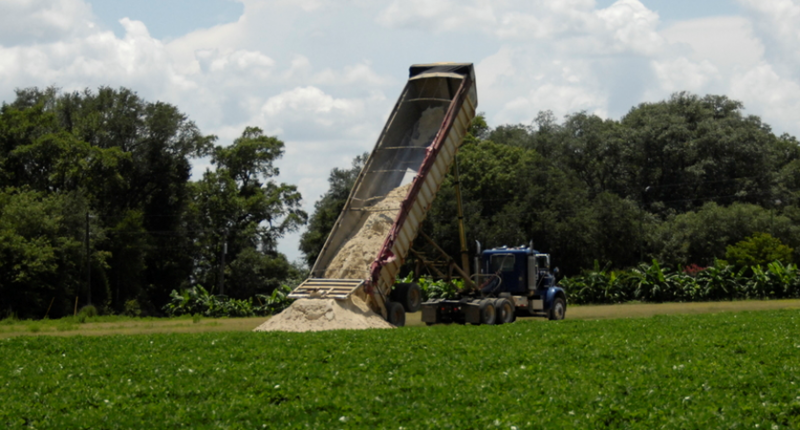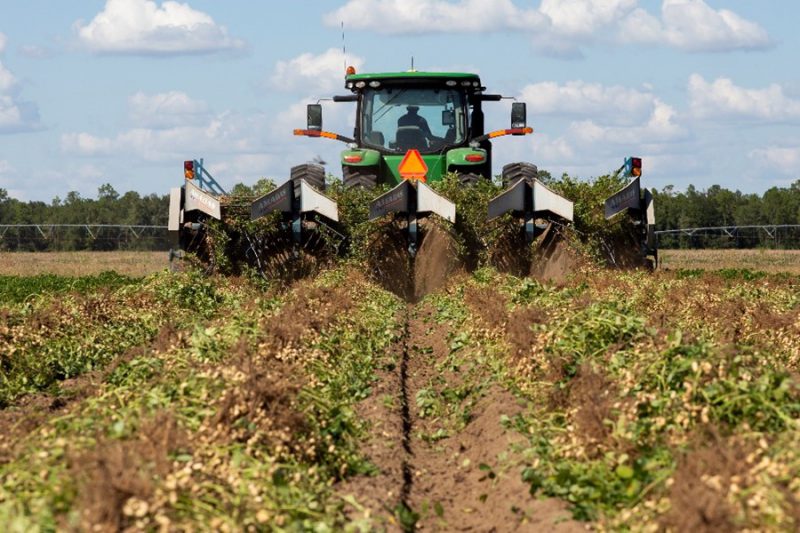De Broughton, UF/IFAS Regional Row Crop Agent, Michael Mulvaney, UF/IFAS Cropping Systems Specialist, Glen Harris, UGA Extension Agronomist, Dalton Tiner, UF/IFAS Extension Assistant, and Kelsey Stellar, UF/IFAS Extension Assistant
What is the importance of calcium to peanut production?
Peanuts are a legume containing a deep-rooted tap root with a series of smaller lateral roots. Because of a vigorous root system, peanuts are a good scavenger of many nutrients, but calcium is the most critical element for good pod yield and is often times hard to access by the plant in North Florida’s sandy soils. Lack of absorption of calcium into the peanut hull in the pegging zone can result in pops (no full kernels inside the pods), reducing yield. Calcium deficiency of peanuts can also encourage or lead to pod rot diseases. Sufficient calcium is highly critical for good germination and seedling vigor when peanuts are produced for seed. In North Florida, calcium is routinely applied as lime in the fall, and applied as gypsum at pegging, for rapid replenishment of available calcium. The amount of calcium taken up by the plant is dependent on the concentration in soil solution and on the amount of water moving into the plant. Since peanuts are often grown on sandy soils, which are prone to drought, there is limited ability of these soils to replenish the soil solution calcium. Heavier soils and irrigated soils are better able to supply needed calcium. Compared to other crops, the peanut has a rare need for calcium because of the nutrient demand required for seed maturation and quality.
–
What are the differences between calcium sources used on peanuts?
–
- Lime
If an increase in pH is needed, a lime source can be surface applied months in advance for gradual breakdown into the soil solution. Lime should be added if the soil pH is below 5.8, with the target pH being 6.2–6.5. If lime is needed, both dolomitic or calcitic lime can be used. Both types increase pH and reduce soil acidity. Calcitic lime is derived from deposits of primarily calcium carbonate. If magnesium is needed, a dolomitic lime can be selected, because it has higher concentrations of magnesium, as it is sourced from deposits containing both calcium carbonate and magnesium carbonate. Lime sources need time to solubilize, so applications must be made months in advance for reactions to occur in the soil and for optimal plant uptake by the time plants need it during reproduction. If you are deep turning soil, applying lime beforehand will enhance distribution and raise pH faster in the root zone. Lime should be applied to fields well in advance of planting and may be applied to strip-tilled fields as a surface application as well. If a lime source is surface applied after planting peanut, it won’t have time to raise the pH or be fully available in time for Ca uptake by pods.
–
-
Gypsum
In addition to the lime application (for pH adjustment), a gypsum application may be needed in-season once bloom and pegging begins. This is especially true for large-seeded varieties or for peanuts grown for seed. Gypsum, or calcium sulfate, can move more quickly through the soil profile than lime, making an application at early bloom very beneficial for healthy pod development. In a dryland scenario, gypsum is more important because lime may not break down and move to the root zone quick enough, if no moisture is present for chemical reactions to occur. Dryland peanut farmers should consider gypsum a necessity if soil moisture levels are low.
Gypsum applications should be made at early bloom or approximately 30-45 days after planting. Since peak pod fill is around 60-90 days after planting, a grower can benefit from gypsum applications made as late as 60 days after planting, although not optimal. Remember that limited soil moisture prevents calcium uptake by the peanut plant, due to lack of calcium in soil solution, so soil moisture is very important. Sandy soils in some peanut growing regions of North Florida have low moisture retention, which can quickly lead to a calcium deficiency from lack of breakdown and absorption.
–

Figure 2.
In Florida, gypsum is freighted to local distributors for use on peanut fields from coal burning power plants or phosphate mines. Lime is sourced from lime-rock mines and crushed for application to fields. Producers broadcast apply the dry material. Photo credit, UGA Extension
–
Sources of gypsum
Gypsum or calcium sulfate, also known as “landplaster”, can be derived from multiple sources. However, these sources have become increasingly more difficult to find over the past several years, and the cost of gypsum has increased.
One source of gypsum, “phosphogypsum,” a by-product generated from phosphorus mines, is very common in Florida. Much of the phosphogypsum previously used for calcium applications to peanut fields is being procured to create wallboard, which is now in high demand and used for construction. This source has become increasingly scarce due to competition with the demand for wallboard products used in that industry.
Another common source is referred to as “smokestack gypsum” or “flue gas desulfurization (FGD) gypsum,” which is a a by-product waste from coal burning powerplants. Many coal burning power plants have switched to natural gas, because it is less expensive and a much cleaner process, with little waste. As a result, this gypsum source is less available for use as well.
–
Can I get away without using any gypsum at pegging?
As stated before, calcium is extremely important for good seed germination, seedling vigor, and for healthy pod fill for all peanut types and markets. Peanuts can be “pegging zone” tested to see how much gypsum needs to be applied at the critical time. A pegging zone sample should be collected in the top 3-4 inches of soil soon after peanuts emerge. If the soil test shows your soil calcium levels are over 500 lb Ca/acre (or 250 ppm Ca), and the calcium to potassium ratio is 3:1 or higher, then the availability of calcium is adequate and no gypsum is recommended. If either of those requirements are not met, then 800-1,000 lbs/acre of gypsum should be applied at early bloom (or more if growing seed peanut – refer to your contract). Remember, gypsum is more important in dryland compared to irrigated acres, so that should also be considered when determining whether or not to apply and the timing of application.
For more information on peanut calcium related topics, please contact your local UF/IFAS County Extension agriculture agent.
–
References:
Wright, D.L., Mackowiak, C. 1992, revised 2017. Liming of agronomic crops. UF/IFAS EDIS publication, SS-AGR-153.
Harris, G. 2020. How to deal with a potential gypsum shortage this year.
Mulvaney, M., 2021. Peanut Video Series – Gypsum Applications. May 6, 2021.
- Farming More Efficiently with Grid Soil Testing and Precision Nutrient Application - November 12, 2021
- Calcium for Peanut Production in North Florida - May 28, 2021
- Evaluation of Controlled Release Fertilizers for Crop Production in Florida - December 11, 2020

